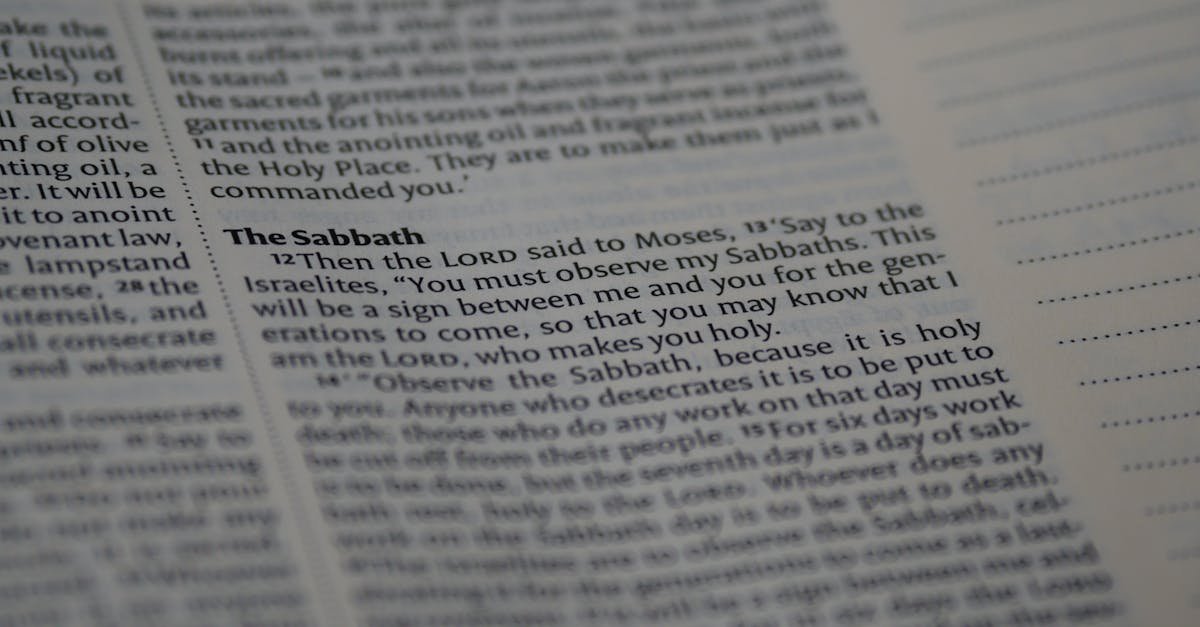When I first started reading the Bible, I found some versions incredibly challenging to understand. The archaic language and complex sentence structures made it tough to grasp the deeper meanings. If you’re like me, searching for an easier version of the Bible can feel overwhelming with so many options out there.
Thankfully, modern translations aim to make the text more accessible without losing its essence. Whether you’re new to Bible study or just looking for a version that’s easier on the eyes and mind, there’s a translation out there that fits your needs. Let’s explore some of the easiest versions of the Bible that can make your spiritual journey more enjoyable and insightful.
Understanding Bible Versions

Today’s Bible readers often find traditional versions difficult due to archaic language and complex sentence structures. Luckily, modern translations aim to make the text more accessible without losing its essence. Let’s dive into why different translations are important and how they’ve evolved over time.
Importance of Different Translations
Having various Bible translations is crucial. Different translations help to capture the nuances and depth of the original texts. For instance, some translations focus on word-for-word accuracy, while others prioritize readability. This variety can cater to diverse needs and preferences. The New International Version (NIV) balances accuracy and readability, making it popular. Meanwhile, the New Living Translation (NLT) focuses on readability, using contemporary language that resonates with modern readers.

Different translations also address different contexts. A language that was common centuries ago might not make much sense today. By offering versions like the Easy-to-Read Version (ERV), translators ensure that even people who aren’t fluent in ancient languages can understand the Bible’s message clearly.
Historical Context and Translation Methods
Understanding the historical context and translation methods brings clarity to why different versions exist. The earliest Bible translations were in Hebrew and Greek—not easily accessible to everyone. The Latin Vulgate, translated by St. Jerome in the 4th century, was a significant milestone, making the Bible accessible to Latin-speaking communities.
Fast forward to the 16th century, the King James Version (KJV) emerged, renowned for its majestic language and literary beauty. Ain’t it beautiful? Yet, translating the Bible isn’t just about converting words from one language to another. It’s about conveying meaning and cultural context.
Modern translations use rigorous methods to ensure accuracy. Committees of scholars work meticulously, comparing ancient manuscripts and studying historical contexts. The English Standard Version (ESV) uses an “essentially literal” translation method, striving for a word-for-word translation. On the other hand, the Message Bible (MSG) uses a more dynamic approach, aiming to capture the thought and spirit of the original text in a way that’s lively and conversational.
So, when choosing the easiest version of the Bible, consider what you’re looking for: readability, accuracy, or a balance of both. Each version has its strengths, and understanding the context and methods behind them can help you make an informed choice.
Features of the Easiest Versions of the Bible
With so many Bible translations out there, it’s essential to pick one that’s easy to read, especially if you’re just starting or want a fresh perspective. I’ll walk you through some of the standout features of the easiest versions of the Bible. They’ll help you connect with the text in a way that’s both accessible and meaningful.
Simple Language and Readability
Simple language is key when looking for an easy-to-read Bible. Modern translations focus on everyday language instead of ancient terms. These versions typically use shorter sentences and familiar words. This makes it simpler to grasp the text without needing a dictionary.
- Contemporary Vocabulary: Modern Bibles avoid archaic words like “thee” and “thou,” using “you” and “your” instead. This shift ensures readers don’t stumble over outdated terms.
- Clear Sentence Structure: Simplified sentence structures help in understanding the meaning without re-reading passages multiple times.
- Narrative Flow: Some translations, like The Message, adopt a more conversational tone, feeling more like a story you’re reading to a friend.
For example, instead of saying “And it came to pass,” an easy version might say, “Then it happened.” Cutting down on formality makes a huge difference.
Popular Versions: NIV, NLT, and The Message
When it comes to accessible Bible translations, three versions routinely come up: the New International Version (NIV), the New Living Translation (NLT), and The Message (MSG). Let’s break down what makes each of these versions popular.
New International Version (NIV)
The NIV is one of the most widely-read Bible translations. It strikes a proper balance between simplicity and accuracy. Scholars worked hard to make it both understandable and faithful to the original texts.
- Balanced Translation: It uses a mix of word-for-word and thought-for-thought translation methods.
- Widely Accepted: Many churches and Christian groups use the NIV, making it versatile for study groups and personal reading.
- Accessible Language: While accurate, the language remains modern and easy to understand.
New Living Translation (NLT)

The NLT is another top choice for those seeking clarity and ease. It leans more towards a thought-for-thought translation, prioritizing the conveyed message over literal word-for-word accuracy.
- Thought-for-Thought Approach: Easier to read because it focuses on conveying the intended meaning of the original text.
- Engaging and Relatable: Perfect for devotions as it captures the essence of the scripture in a relatable way.
- Smooth Readability: Its flow is easy on the eyes and mind, making it great for both new believers and seasoned readers.
Benefits of Using an Easy Version
Using an easy version of the Bible comes with many advantages. Whether you’re new to reading the Bible or looking to enhance your study routine, these benefits can make a significant difference.
Accessibility for Beginners
Many people find traditional Bible translations difficult to understand. Easy versions solve this problem by using simple language. For example, the New Living Translation (NLT) is known for its readability. It helps newcomers grasp biblical concepts without struggling with archaic words or complex phrases.
These versions also often include helpful features. Study aids, annotations, and summaries can guide beginners through difficult passages. The Message Bible (MSG), for instance, paraphrases the text, capturing the essence without drowning readers in ancient language. This approach can make Scripture feel more approachable and engaging.
Enhancing Daily Bible Study
Daily Bible study needs to be both enriching and feasible. An easy version of the Bible can make this possible by simplifying the text. When you don’t have to spend extra time decoding old terminologies, you can focus more on applying the lessons to your life.
Moreover, easy versions usually come in various formats catered to modern lifestyles. Digital editions often have search functions and cross-references that make study more interactive. Think of the New International Version (NIV), which offers both online platforms and mobile apps, bringing convenience right to your fingertips. These tools can make your daily routine more consistent and fulfilling.
In sum, moving to an easy version of the Bible can transform how both beginners and seasoned readers interact with Scripture, enriching their spiritual journey in a practical and accessible way.
Comparing Traditional and Simplified Versions
Modern Bible translations make the text more accessible without losing its essence. Now, let’s dive into the differences between traditional and simplified versions.
Linguistic Differences
Traditional versions like the King James Version (KJV) often use archaic language, which can be tough to understand. Words like “thee” and “thou” aren’t used in everyday conversation, making reading feel like a history lesson. Sentences are longer and more complex, reflecting the linguistic style of the time.
On the other hand, simplified versions like the New Living Translation (NLT) use contemporary language. For instance, instead of “thy” and “thine,” you’ll find “your” and “yours”. These versions aim for clarity with shorter sentences and common words, making the text smoother and more relatable.
Impact on Interpretation

Traditional versions tend to stick closer to the original Hebrew and Greek texts. This can be a double-edged sword. While maintaining accuracy, the meaning might get lost if the reader isn’t familiar with ancient language nuances.
Simplified versions focus on translating ideas rather than word-for-word accuracy. This can help readers grasp the intended message more easily. However, these versions might sometimes sacrifice some of the original text’s depth and intricacy in favor of readability.
Choosing between traditional and simplified versions depends on personal preference and purpose. If you’re studying deeply, a traditional version might be beneficial. But if you’re looking to understand biblical narratives better, a simplified version could be the way to go.
Both have their strengths, and understanding these differences can help make an informed choice tailored to one’s spiritual journey.
Recommended Easy Versions for Specific Audiences
Choosing a Bible that suits individual needs can make a significant difference in one’s spiritual journey. I’ll share my recommendations for easy-to-read versions suited for specific audiences, from children to non-native English speakers.
Children and Youth

For children and youth, accessibility and engagement are key. Here are my top picks:
- New International Reader’s Version (NIrV)
The NIrV breaks down the New International Version into shorter sentences and simpler words. It’s ideal for younger readers, particularly those around age 6-12. It retains the original meaning but makes the text more digestible. For instance, John 3:16 in NIrV reads, “God so loved the world that he gave his one and only Son. Anyone who believes in him will not die but will have eternal life.” - New Living Translation (NLT)
The NLT suits older children and teens. Crafted for clarity, it uses contemporary language while staying true to original meanings. I’ve found that teenagers appreciate its narrative style, making books like Genesis and the Gospels more engaging. Take Matthew 11:28, “Come to me, all of you who are weary and carry heavy burdens, and I will give you rest.” This version strikes a balance between readability and maintaining scriptural depth. - The Action Bible
Geared towards kids and pre-teens, The Action Bible presents biblical stories in comic-book style. It enables young readers to visualize and understand complex narratives. My Sunday school classes often rave about its vibrant illustrations coupled with accessible text.
Non-Native English Speakers
Non-native English speakers benefit from translations that emphasize clarity and simplicity. Here are suitable options:
- Good News Translation (GNT)
The GNT, also known as Today’s English Version (TEV), simplifies complex sentences and uses everyday language. It works well for those learning English as it avoids idiomatic expressions and archaic terms. John 1:1 in GNT: “In the beginning the Word already existed; the Word was with God, and the Word was God.” This straightforward approach helps readers focus on understanding without linguistic hurdles. - Contemporary English Version (CEV)
The CEV, focusing on clarity and simplicity, suits individuals at varying levels of English proficiency. It avoids theological jargon, making it accessible. For example, Psalm 23:1 in CEV reads, “You, LORD, are my shepherd. I will never be in need.” The CEV aids comprehension and fluency, making it easier to grasp spiritual messages. - New International Reader’s Version (NIrV)
Besides being great for children, the NIrV helps non-native speakers progress in their English reading skills while exploring the Bible. Its clear and simple text makes it a dual-purpose tool for language learning and spiritual growth.
Conclusion
Navigating the world of Bible translations can be a bit overwhelming but finding the right version can make all the difference in your spiritual journey. Modern translations like the NIV and NLT offer a great balance of readability and accuracy. For younger readers or those new to English the NIrV and GNT are excellent choices that make the Bible’s messages more accessible. It’s all about finding what resonates with you and supports your understanding and growth. Happy reading!
Frequently Asked Questions
Why is understanding traditional versions of the Bible challenging?
Understanding traditional versions of the Bible can be challenging due to archaic language, complex sentence structures, and historical context that may not be easily comprehensible to modern readers.
What is the importance of modern Bible translations?
Modern Bible translations are important because they make the text more accessible, ensuring that readers can understand and engage with the biblical teachings more effectively in contemporary language.
How do modern translations balance accuracy and readability?

Modern translations balance accuracy and readability by employing scholarly research on ancient texts while using contemporary language to ensure the Bible is both faithful to the original manuscripts and approachable for modern readers.
Which Bible versions are considered easy-to-read?
Bible versions considered easy-to-read include the New International Version (NIV) and the New Living Translation (NLT), both of which use modern language and straightforward sentence structures.
What are some recommended Bible versions for children?
For children, the New International Reader’s Version (NIrV) is recommended due to its simplified language that is easier for young readers to understand.
Are there Bible versions suitable for non-native English speakers?
Yes, the Good News Translation (GNT) is well-suited for non-native English speakers as it uses clear and simple language, making the text more accessible to those not fluent in English.
Why is clarity and simplicity important in Bible translations?
Clarity and simplicity are important in Bible translations to ensure that readers of all ages and backgrounds can comprehend the scripture without feeling overwhelmed by complex language and phrasing.
Can easy-to-read Bible versions enhance a spiritual journey?

Absolutely, easy-to-read Bible versions can enhance a spiritual journey by making the texts more approachable, allowing readers to connect with the teachings and apply them to their lives more effectively.












